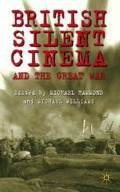Abstract
As the First World War now passes from living memory, the film records that survive are increasingly significant in shaping our understanding of the conflict. Feature films produced in the aftermath indicate how the conflict entered the collective memory and was explored and exploited by cinéastes, writers and performers. When we look again at films such as Blighty (1927), The Guns of Loos and Dawn (1928), we need to remind ourselves that these films were produced almost a decade after the end of the conflict and are part of the process of remembering. Wilfred Wilson Gibson’s poem ‘Lament’, published in a 1926 anthology, expressed this moment of troubled reflection of present upon past beautifully:
We who are left, how shall we look again
Happily on the sun or feel the rain
Without remembering how they who went
Ungrudgingly and spent
Their lives for us loved, too, the sun and rain?1
Most films of the early and mid-1920s were made with the benefit of hindsight and at a respectful distance. But by the late 1920s, respect and mourning were giving way to critique and questioning, indicated, for example, by the publication of poems by Siegfried Sassoon and Wilfred Owen and Robert Graves’ Goodbye to All That.
Access this chapter
Tax calculation will be finalised at checkout
Purchases are for personal use only
Preview
Unable to display preview. Download preview PDF.
Notes
Wilfred Wilson Gibson, ‘Lament’ (first stanza), Collected Poems 1905–1925 (London: Macmillan, 1926), also available at http://net.lib.byu.edu/english/WWI/poets/Lament.html [accessed 1 November 2010].
The American ambassador warned of the success of German propaganda with impressionable audiences. The reluctance to embrace cinema was due to officials’ overall distaste of the perceived working-class medium and the desire not to replicate the staged examples of the Boer War, but to produce actualities. The newsreel was only a couple of years old and there were practical issues with getting cameramen to the front. See Nicholas Reeves, ‘Official British Film Propaganda’, in Michael Paris (ed.), The First World War and Popular Cinema 1914 to the Present (Edinburgh: Edinburgh University Press, 1999), p. 28.
Nicholas Hiley, ‘The British Cinema Auditorium’, in Karel Dibbets and Bert Hogenkamp (eds), Film and the First World War (Amsterdam: Amsterdam University Press, 1999), p. 162.
‘Allies Despise All Americans: Wilson Hissed in London Film Show’, Chicago Daily Tribune, 6 Feb 1916, 3; on Chaplin, see Hammond, The Big Show: British Cinema Culture in the Great War (1914–1918) (Exeter: University of Exeter Press, 2006), p. 231.
Hammond, The Big Show, p. 1. Hammond cites F. R. Goodwin, Chairman of the Cinematograph Exhibitors’ Association, London Branch, in National Council of Public Morals [NCPM], The Cinema: Its Present Position and Future Possibilities (London: Williams and Norgate, 1917 [New York: Arno Press and the New York Times, 1970]), p. 1.
Editor information
Editors and Affiliations
Copyright information
© 2011 Bryony Dixon and Laraine Porter
About this chapter
Cite this chapter
Dixon, B., Porter, L. (2011). ‘How Shall We Look Again’? Revisiting the Archive in British Silent Film and the Great War. In: Hammond, M., Williams, M. (eds) British Silent Cinema and the Great War. Palgrave Macmillan, London. https://doi.org/10.1057/9780230321663_13
Download citation
DOI: https://doi.org/10.1057/9780230321663_13
Publisher Name: Palgrave Macmillan, London
Print ISBN: 978-1-349-33237-3
Online ISBN: 978-0-230-32166-3
eBook Packages: Palgrave Media & Culture CollectionLiterature, Cultural and Media Studies (R0)

